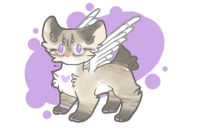
Archive - Item Shop - Adoptions - Guidelines and Info
----------------------------------------------------------------------------------------------------
Two new Pik-Piks up for Adoption!
Posted new items in the shop!
Litter #2 is up for adoption!
Litter #3 is up for adoption!
Litter #4 is up for adoption!
---------------------------------------------
4/25/17- Creation of thread
4/26/17- Opening the thread
4/27/17- Posted the first two Pik-Piks.
5/8/17- Posted the second litter.
5/15/17- Posted the third litter.
5/28/17- Posted the fourth litter.
----------------------------------------------------------------------------------------------------

Pik-Piks are small birds who have two heads. The head on the tail has a mind of it's own. It can go without eating for 3 months. But the main head with the body is most important when it's alive.They're as big as an Adelie penguin, and the noise of a squeaking newborn kitten. They don't walk on all four since it's front paws are very small. However their ancestors are the velociraptors. They can stand on both of its hing legs, they could run as fast as a male lion. Also they can jump like a kangaroo, this helps them prevent from any danger that follows them.
----------------------------------------------------------------------------------------------------


Their tails are most important of all to the Pik-Piks. They can die from depression and being lonesome, this is why they need their tails for companionship. They're called 'Buddy Tails', the Buddy Tail is a separate organism but they breathe from the same body and share the same heart. If one of them dies, it's not possible for them to live very long. Some records show, once they're in the stage of dying they'll only survive about 3 hrs.
----------------------------------------------------------------------------------------------------

----------------------------------------------
- Normal Whiskers and Hair above jawline
Common Pik-Piks are seen anywhere around the world. Some litters can
have a 80% chance of being pure Commons and a 20% chance contain a
type of trait from any other rarities in each egg group.
- Long Whiskers, hair over jawline and claws
Uncommon Pik-Piks have these types of traits from the 20% egg group
from new litters. But these types of Pik-Piks have a high chance
of have a litter with a 10% chance of getting a rare trait in the rare
egg group.
- Small Whiskers, long hair to hind legs, and small beak
Rare Pik-Piks in some parts of the much in the rarer category. It's 10% chance
of getting on in a new litter. If breed with a common and an uncommon
Pik-Pik it's a in between risk of getting in a new litter.










































